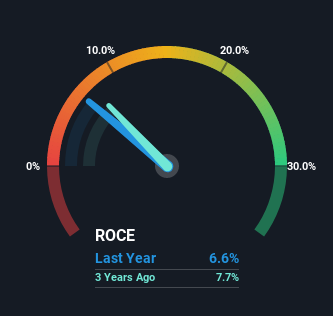Investors Could Be Concerned With Juniper Networks' (NYSE:JNPR) Returns On Capital
When it comes to investing, there are some useful financial metrics that can warn us when a business is potentially in trouble. A business that's potentially in decline often shows two trends, a return on capital employed (ROCE) that's declining, and a base of capital employed that's also declining. Basically the company is earning less on its investments and it is also reducing its total assets. So after we looked into Juniper Networks (NYSE:JNPR), the trends above didn't look too great.
Return On Capital Employed (ROCE): What is it?
For those that aren't sure what ROCE is, it measures the amount of pre-tax profits a company can generate from the capital employed in its business. The formula for this calculation on Juniper Networks is:
Return on Capital Employed = Earnings Before Interest and Tax (EBIT) ÷ (Total Assets - Current Liabilities)
0.066 = US$460m ÷ (US$8.8b - US$1.9b) (Based on the trailing twelve months to March 2022).
Therefore, Juniper Networks has an ROCE of 6.6%. Ultimately, that's a low return and it under-performs the Communications industry average of 9.0%.
See our latest analysis for Juniper Networks
Above you can see how the current ROCE for Juniper Networks compares to its prior returns on capital, but there's only so much you can tell from the past. If you'd like, you can check out the forecasts from the analysts covering Juniper Networks here for free.
What The Trend Of ROCE Can Tell Us
There is reason to be cautious about Juniper Networks, given the returns are trending downwards. About five years ago, returns on capital were 12%, however they're now substantially lower than that as we saw above. On top of that, it's worth noting that the amount of capital employed within the business has remained relatively steady. This combination can be indicative of a mature business that still has areas to deploy capital, but the returns received aren't as high due potentially to new competition or smaller margins. So because these trends aren't typically conducive to creating a multi-bagger, we wouldn't hold our breath on Juniper Networks becoming one if things continue as they have.
Our Take On Juniper Networks' ROCE
In summary, it's unfortunate that Juniper Networks is generating lower returns from the same amount of capital. In spite of that, the stock has delivered a 12% return to shareholders who held over the last five years. Regardless, we don't like the trends as they are and if they persist, we think you might find better investments elsewhere.
Like most companies, Juniper Networks does come with some risks, and we've found 3 warning signs that you should be aware of.
While Juniper Networks isn't earning the highest return, check out this free list of companies that are earning high returns on equity with solid balance sheets.
Have feedback on this article? Concerned about the content? Get in touch with us directly. Alternatively, email editorial-team (at) simplywallst.com.
This article by Simply Wall St is general in nature. We provide commentary based on historical data and analyst forecasts only using an unbiased methodology and our articles are not intended to be financial advice. It does not constitute a recommendation to buy or sell any stock, and does not take account of your objectives, or your financial situation. We aim to bring you long-term focused analysis driven by fundamental data. Note that our analysis may not factor in the latest price-sensitive company announcements or qualitative material. Simply Wall St has no position in any stocks mentioned.

 Yahoo Finance
Yahoo Finance 
